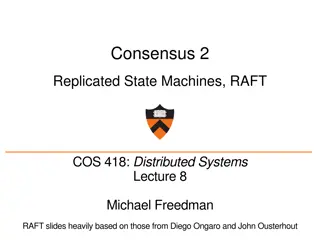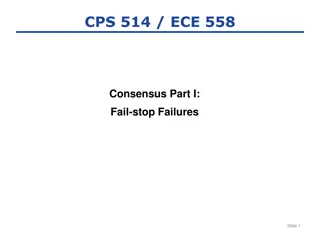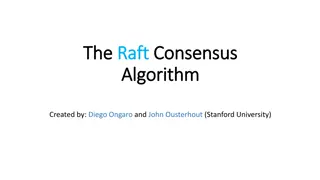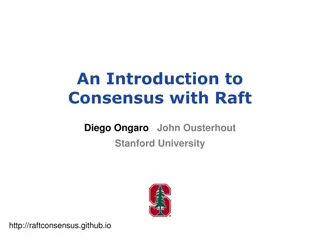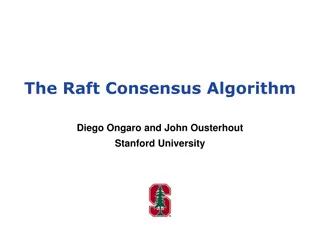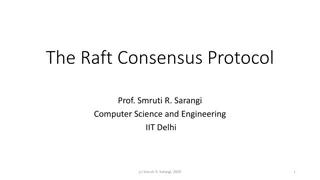Enhancing Distributed Consensus: Combining PBFT and Raft for Improved Security
Addressing challenges in distributed systems, this study proposes a novel approach by combining PBFT and Raft consensus mechanisms to enhance scalability and fault tolerance. The research highlights the importance of secure data storage and identifies new attack mechanisms in today's digital landscape. By utilizing a combined PBFT and Raft consensus approach, the system achieves a higher level of consensus and data protection. The 1-level PBFT processing and 2-level Raft processing are explained in detail, showcasing how nodes collaborate to ensure reliable and secure distributed consensus.
Download Presentation

Please find below an Image/Link to download the presentation.
The content on the website is provided AS IS for your information and personal use only. It may not be sold, licensed, or shared on other websites without obtaining consent from the author. Download presentation by click this link. If you encounter any issues during the download, it is possible that the publisher has removed the file from their server.
E N D
Presentation Transcript
Combining PBFT and Raft for Scalable and Fault-tolerant Distributed Consensus Alexander Bogdanov, Nadezhda Shchegoleva,Valery Khvatov, Aleksandr Dik, Jasur Kiyamov
Data storage problem In today's digital world, the protection of personal information plays a key role, as there is a risk of leakage and unauthorized access to this data. When data is transferred between systems and devices, strong security must be in place to prevent eavesdropping, compromise of the data in transit. manipulation, or
New attack mechanisms 1. Attacks using artificial intelligence 2. Application Layer Attacks 3. Social engineering 4. Cryptocurrency attacks
Combined P-BFT and RAFT consensus approach Using a combined P-BFT and RAFT consensus approach on virtualized hosts can be an effective solution to improve the security and reliability of a distributed network. Each of these protocols has its own advantages, combination allows to achieve a higher level of consensus and data protection. Node 2 0 2 Node 1 Node 3 and their 0 2 0 2 Node 4 0 2
1-level processing P-BFT consensus 1. Request Initiation: The client initiates a request by sending it to all nodes in the system. CUSTOMER ? The client starts a transaction 2. Preliminary phase: In this phase, the nodes exchange messages to reach a preliminary agreement. INITIATOR The initiator performs its verification and primary validation 3. Prior consent phase: In this phase, nodes collect proposals and signatures from most of the other nodes. Round voting LEADER 4. Commit phase: In this phase, nodes collect proposals and signatures from most other nodes. CLUSTER NODES 5. Final agreement phase: In this phase, the nodes exchange messages to reach a final agreement. ARBITERS Arbitration
2-level RAFT processing by consensus 1. Leader selection: At the beginning of the system, one of the nodes is selected as the leader. The leader is responsible for making decisions and coordinating operations in the system. 2. Log distribution: The leader accepts transactions and data from clients and adds them to their local log. The leader then sends log entries (entries) to the rest of the nodes in the system. 3. Log replication: The remaining nodes receive log entries from the leader and store them in their local logs. The nodes also send acknowledgments to the leader indicating that they have successfully received the writes. 4. Log commit: When the leader receives acknowledgments from most of the nodes (more than half), it commits the entries in its log and sends a commit message to all nodes. Nodes apply fixed records to their states by updating the distributed ledger. 5. Failover: If a leader fails or becomes unavailable, another node initiates the process of electing a new leader. The nodes use voting and timers to choose a new leader and restart the system. Follower Candidat Leader
Attack resistance P-BFT is highly resistant to malicious attacks such as spoofing attempts or host attacks. At the same time, RAFT provides high system availability and node failure detection. The combined approach allows you to strengthen protection against various types of attacks and reduce the likelihood of successful intrusions.
Scalability Virtualized nodes make it easy to scale the system, add new increase its throughput. The combined approach of P-BFT and RAFT can work effectively virtualized provide system flexibility and scalability. nodes and on and hosts
Productivity increase The combination of P-BFT and RAFT can help improve system performance. P-BFT enables fast consensus in a low node environment, while RAFT enables efficient log management and high data availability. This allows you to achieve high performance and efficiently process transactions in a distributed network.
Security Guarantees The combined approach provides additional guarantees for data security. P-BFT provides protection against unauthorized access and data spoofing, while RAFT helps to detect and recover from node failures. This allows you to create a reliable and secure environment for the exchange and storage of data.
Conclusion Based on the results of the research, the following conclusions can be drawn: 1. The creation of virtual machines that implement the operating environment of the blockchain system is an important step in the development of heterogeneous software and hardware systems. 2. The developed methodology for launching applications in multi-level virtual environments really makes it possible to increase the overall performance of such complexes. 3. The developed approach to building the operating environment of the user subsystem provides secure user access to resource-intensive applications in a heterogeneous distributed cloud computing environment. 4. The study of methods for improving the reliability of authentication and authorization and the developed methodology for their application in a heterogeneous cloud environment are important components for ensuring the security of such systems.






